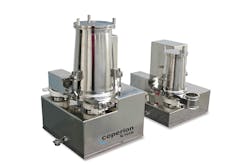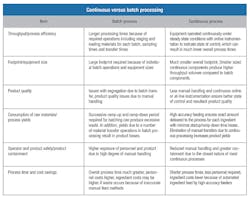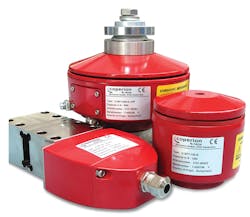Defining feeder accuracy for continuous processing
Continuous processing is a manufacturing practice that has been used in the plastics, chemical and food industries for decades. Although primarily used for liquid processing, the innovations made in dry powder feeder technologies have enabled the use of continuous dry ingredient feeding for a variety of applications.
Even advances in the traditional batch pharmaceutical industry have paved the way forward for implementation of continuous processing for tableting. The recent U.S. Food and Drug Administration approvals of drug formulations made by continuous processes for Vertex and Janssen Pharmaceuticals, both using continuous loss-in-weight (LIW) feeder technologies, have indicated an ongoing paradigm shift in this industry.
Processes such as continuous blending/mixing, continuous milling/micronization, continuous hot melt extrusion, continuous wet extrusion or granulation, and continuous coating are just a few examples of the processes used by many industries. At the heart of each of these continuous processes is the LIW feeder. This article defines the items necessary for accurate feeding and outlines the important role that accuracy can play in the end product and process quality of any continuous operation.
Advantages & definitions of continuous processing
During batch processing, each raw material and active ingredient must be added in the right amounts (and sometimes in the right order), following processing instructions that are spelled out by the overall recipe that governs the process. Continuous processes have many similarities to batch processes in that they, too, require all raw materials and active ingredients to be dosed into the process in the right amount, at the right time and in accordance with the governing recipe.
However, during continuous processing, the introduction of these materials must be carried out continuously, and the final product is manufactured in a continuous stream, not in discrete batches. In a continuous process, all the equipment componentsrelated to the required unit operations function as a single system and are designed to operate 24 hours per day, seven days per week (except during required maintenance). In most cases, increased equipment utilization and economies of scale associated with continuous processing create many cost savings and operational efficiencies (see Table 1).
Although continuous processes were traditionally thought to be best suited for producing high-volume products, the evolution of low-rate, high-accuracy feeders such as the Coperion K-Tron Microfeeder, (see Image 1) allow for continuous processing ingredient rates as low as 50 grams per hour (g/hr).
These low rates are critical to the accurate introduction of low percentage ingredients such as active pharmaceutical ingredients (APIs) in the pharmaceutical industry or high-value flavors and additives in the plastics, chemical and food industries.
Feeders for continuous processing defined – Volumetric or gravimetric?
During some continuous or semicontinuous process operations, volumetric feeders and gravimetric feeders can be used to deliver bulk solids into the process, depending on the nature of the materials and the process needs. However, to ensure accurate delivery on short times scales, gravimetric feeders are essential.
Volumetric feeders for continuous processing
As the name implies, volumetric feeding discharges discrete volumes of material per unit time into a process. These are the simplest feeder options available and are often used in applications where feed accuracy may not be critical, as in continuous or semicontinuous operations such as milling or micronization. It should be noted, however, that while they are simple and relatively inexpensive, no weight information is captured or considered during discharge. As a result, volumetric feeders are essentially open-loop devices, whose final discharge rate is a function of constant feeder speed and is not governed by any ongoing data feedback from the operation.
Since these systems cannot detect or adjust to variations in the material’s bulk density, the actual amount of material delivered to the process (the mass flow) can vary with time. This makes volumetric feeders inappropriate for many process applications that have rigorous accuracy requirements.
Another potential drawback for volumetric feeders is that they cannot detect (and thus do not alert the operator) when the hopper that supplies the feeder has run out of material, or when a bridge, arch or rathole may have formed in the hopper, interrupting the flow of material (by contrast, gravimetric feeders can detect and alert the operator to these conditions). This can, of course, drastically affect continuous operating performance because material feeding to the process may be reduced.
Gravimetric feeders for continuous processing
Unlike the volumetric screw feeder, an LIW feeder is a gravimetric feeder that directly measures the material’s weight to achieve and maintain a predetermined feed rate that is measured in units of weight per time. The bulk material or liquid is discharged from a hopper by weighing the material being fed and regulating the speed of the feeding device. The weighing system with control compensates for nonuniform flow characteristics and variations in bulk density and, therefore, provides for a high degree of feeding accuracy.
Gravimetric feeders measure the flow’s weight in one fashion or another and then adjust feeder output to achieve and maintain the desired setpoint. The LIW feeder (see Figure 1) consists of a hopper, refill device, weight-sensing device (typically either a digital or analog load cell), feeder (typically a volumetric screw feeder powered by a variable speed motor) and controller.
Before operation, an operator programs the controller to discharge material at a predetermined feed rate (or setpoint) measured in units of weight per time (such as pounds per hour). As the feeder discharges material, system weight declines. The speed of the metering device is controlled to result in a per-unit-time loss of system weight equal to the desired feed rate. A typical LIW feeder controller adjusts the feeder speed to produce a rate of weight loss equal to the desired feed rate setpoint.
The most common type of gravimetric feeder device used in continuous processing is the LIW screw feeder. LIW feeding provides broad material handling capability and excels in feeding a wide range of materials from low to high rates. With this technology, a constant mass flow is ensured for consistent product output from the process.
Not only do LIW feeding systems deliver precise discharge rates, they also provide immediate alerts if any interruption occurs of material flow from the storage bin that supplies the feeder. Real-time gravimetric feeding data supports the feedback loops needed to achieve such sophisticated process control, and access to real-time and historic data gives operators instantaneous feedback and a useful window into the process. These improved analytics support troubleshooting efforts, allow for statistical quality control analysis, and can help operators prevent downstream accuracy or quality problems, factors that contribute to an efficient continuous process.
What is feeder accuracy & how does it relate to continuous processing?
Accuracy is key to quality in any process that employs gravimetric feeders to proportion or control the flow of bulk solids materials. Ever more stringent processing and formulation standards demand a clear understanding of the nature and measurement of feeder performance.
Definition of accuracy in feeder performance evaluation
To fully define feeder accuracy and resultant performance for a batching or continuous operation, it is necessary to address three separate and distinct areas of feeder performance: repeatability, linearity and stability. Repeatability reports how consistent the feeder’s discharge rate is at a given operating point. Linearity assesses how accurately the feeder discharges at the requested average rate across its full operating range, and stability gauges performance drift with time.
Repeatability is the performance statistic most familiar to feeder users. It quantifies the short-term level of consistency of discharge rate. Repeatability is important to quality assurance because it measures the expected variability of the discharge stream and, hence, of the product itself. It is important to note that the repeatability statistic reveals nothing at all about whether the feeder delivers, on the average, the targeted rate. Repeatability only measures the variability of flow rate. It is the linearity statistic that reports how well the feeder delivers the desired average rate throughout the feeder’s operating range. Perfect linearity is represented by a straight-line correspondence between the setpoint and the actual average feed rate throughout the feeder’s specified turndown range from its full-scale operating design point.
A perfectly performing feeder is worth little if it cannot maintain its performance for the long haul. Many factors can potentially contribute to performance drift including feeder type, control and weigh system stability, the handling characteristics and variability of the material, the feeder’s mechanical systems and maintenance, and the operating environment itself. Drift is detected by calibration checks and is typically remedied by a simple weight span adjustment.
In relating this topic of accuracy to the feeder types defined above, for accuracy requirements in the 1 to 5 percent range, volumetric feeders will usually suffice, while gravimetric feeders are used for performances in the 0.25 to 1 percent range.
Feeder options to consider when optimizing a continuous process
In any continuous process that uses feeders to control or proportion materials, the performance standards required of the feeding system begin with the end user. With a view toward producing a product at minimal cost while its various properties consistently conform to predetermined requirements, end users specify tolerances for each ingredient or material. Feeder accuracy requirements are then based on the tolerances set for each material.
LIW feeder performance also depends on two areas that are closely linked:
- The accuracy and speed of weight measurement and the immunity of the weighing system to in-plant vibration and temperature fluctuations.
- The response of the control algorithm and the available features of the control algorithm.
Any LIW process controller requires accurate, high-speed measurement of material weight changes to provide optimal feeder control and performance, especially on a second-to-second basis. The weighing system must also filter out erroneous measurements caused by in-plant vibrations or disturbances and remain stable with changes in process room or process material temperatures.
The higher the resolution of weight measurement and the faster those weight measurements are taken, the better the information provided to the control algorithm and the better any vibration filtering algorithm will work.
It should also be noted that to be sensitive to low mass flow rates, load cells must have an extremely high resolution. For example, a typical scale with an analog load cell for feeding bulk solids at low mass-flow rates can have a weighing range of 32 kilograms (kg) and a resolution of 1-to-65,000. This scale can detect approximately 500-milligram (mg) weight changes.
Typically weight changes per second should be approximately five times higher than the minimum resolution, which is equivalent to 2.5 g/sec (9 kg/hr). When feeding at this rate, the controller takes 20 seconds to detect whether the setpoint is reached within a deviation of +/- 1 percent. If the mass flow rate is less than 9 kg/hr, detecting improvements of gravimetric control versus volumetric control becomes even more difficult. Therefore, any mass flow rate less than 9 kg/hr may not even undergo a significant improvement with gravimetric control.
Conversely, a typical platform scale with a digital load cell with a weighing range of 24 kg and a resolution of 1-to-4,000,000 can detect 6 mg. The limit value can, therefore, be reduced from 9 kg/hr to approximately 108 g/hr.
This is significant for low mass flow rates, such as those for low formulation percentage APIs and also for high required second-to-second accuracy. In addition, higher resolution also results in improved feeder accuracy for high mass flow rates.
Summary
For any continuous process to perform at its peak efficiency, a high-accuracy LIW feeder must be used. LIW feeding demands that the weighing system possess a broad operating range, exceptional linearity, a resolution high enough to accurately discern small changes in total system weight, and the high level of responsiveness needed to make these measurements quickly, “on the fly.”
Measuring, monitoring and maintaining feeder performance begins with understanding the role that accuracy plays in the overall process and the many factors that affect it.
Sharon Nowak serves as global business development manager for the food and pharmaceutical industries for Coperion and Coperion K-Tron. She works closely with the research and development and engineering departments and with worldwide customer requests to identify new applications and provide design and focus on the specific needs of these industries. Nowak has more than 30 years of experience in the process equipment industry for food and pharmaceuticals and a degree in chemical/biochemical engineering from Rutgers University. She has extensive experience designing and integrating feeders and material handling equipment including pneumatic conveying into continuous and batch processes for food and pharmaceuticals including blenders and mixers, mills and micronizers, extruders, granulators and coaters, and contained processes for potent pharmaceutical compounds.
About the Author

Sharon Nowak
Sharon Nowak is global business development manager for food and pharmaceutical ingredients at Coperion K-Tron.





